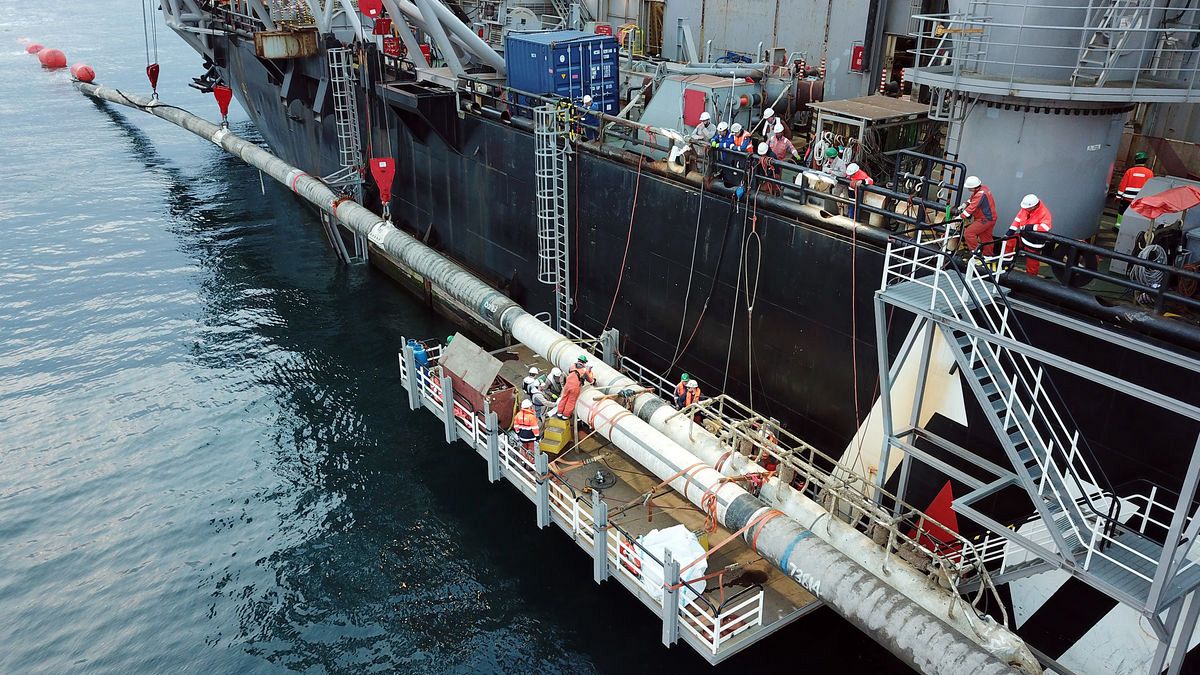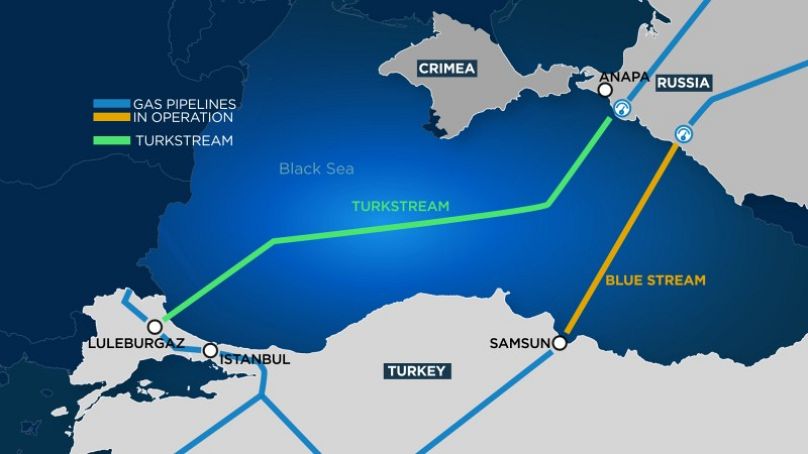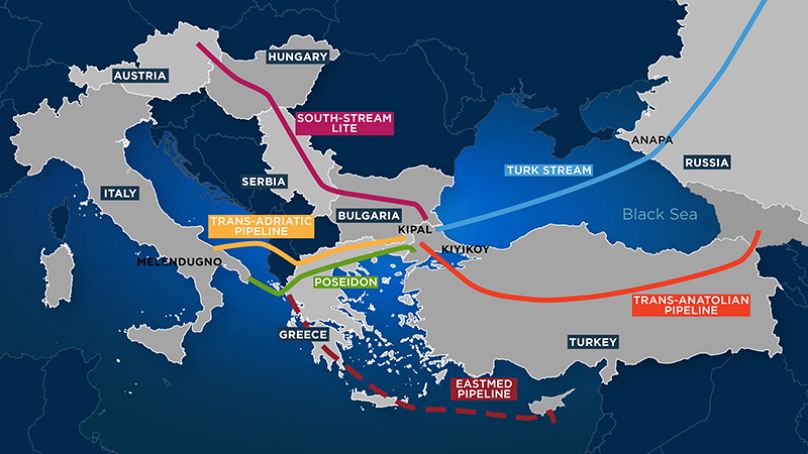The new gas pipeline has a huge impact on energy politics in Europe. Here's what you need to know about TurkStream.
A geopolitical coup for Russia and an economic success for Turkey: the joint TurkStream gas pipeline is live starting Wednesday.
Despite European efforts to diversify energy sources, a lot of European countries are still very dependent on Russian gas. With this new pipeline, that dependency is not getting any less, very much to the joy of Russian President Vladimir Putin.
The cherry on top for Russia: this new pipeline bypasses Ukraine, with whom Russia has been in a simmering conflict since 2014.
Turkey meanwhile is enjoying its ascent to becoming a major gas hub in the region.
All of this is happening against a backdrop of Russian disinformation campaigns in the West, European sanctions against Russia for annexing Crimea and wars in Libya and Syria, where Turkey and Russia are supporting opposite sides.
Here are some of the most important things you need to know about TurkStream:
Where is it?
The new pipeline project replaced the South Stream project and runs along almost the same route.
TurkStream leads from Russia to Turkey, starting at a compressor station near Anapa in Russia. It then crosses the Black Sea and makes a stop in Kıyıköy north-west of Istanbul.
The pipeline runs under the Black Sea for almost 230 kilometres in Russian waters before entering Turkish waters, where it continues for about 700 kilometres.
The offshore parts, as in the parts that run underwater, are made up of two parallel pipelines.
One of the two will connect to Turkey’s existing gas network at Luleburgaz. The other one will continue to the Turkish-European border where it will be connected to the Trans-Balkan pipeline system.
The line has the capacity to transit 31.5 billion m3 (cubic metres) per year in natural gas.
The pipes, which are lying in up to 2,200-metre depths were manufactured by German, Russian and Japanese companies.
Each of the involved countries in South-East and Central Europe is responsible for their own extension of the pipeline.
How much did it cost?
The project was initially estimated to cost €11.4 billion. But the actual cost, factoring in on-land infrastructure, is likely 160% higher than official figures, according to estimates by analysts at Russia’s biggest commercial bank, Sberbank CIS.
TurkStream is the replacement of the South Stream project, running along almost the exact same route. Sergei Kapitonov, natural gas analyst at the SKOLKOVO Energy Center in Moscow told Euronews that huge gas transportation corridors were built across Russia for South Stream, and pipes were ordered for the offshore part. But when that project failed, “Gazprom had to either simply scrap the investments it had already made or to somehow ‘save’ them in a form of a pipeline of reduced capacity. The initial South Stream project had double the capacity of TurkStream.”
Looking at the costs, one could assume that neither TurkStream nor Nord Stream were economically driven projects, but rather political ones. One of Russia’s political motivations is in a way a punishment of Ukraine, with which it has been engaged in a conflict since 2014.
Kapitonov points out that Russia had made the decision to avoid transit risks in terms of its gas export strategy. That is exactly why Nord Stream, Nord Stream 2 and TurkStream were designed.
“In some form, such a strategy was indeed a ‘punishment’ of Ukraine,” he says. “But, after the five-year gas transit contract was signed with Ukraine last month, it cannot be regarded as ‘punishment’, but perhaps as an opportunity given the growing niche for imported gas in Europe from the mid-2020s.”
How does TurkStream affect consumers?
Considering the cost of the project and Europe’s high dependence on Russian gas, customers may wonder whether they will see any changes in their gas bills.
In fact, the new pipeline will optimise transportation costs, but not for all.
According to Kapitonov, “for some customers the transportation distance will increase, for some, it will decrease. Some countries such as Ukraine, Moldova, Romania will lose transit revenues, while Turkey will collect transit revenues.”
However, he notes, this doesn’t mean that gas will necessarily become more expensive for some. Contracts, he says, are usually long-term agreements, some of which last to the mid-2030s. “Many of Gazprom’s contracts are already priced based on Europe gas hubs and their share will grow in the future.”
Who are the winners and the losers?
Just like in any big energy project, there are some winners and some losers with regards to TurkStream, too.
Some of the winning countries here are those participating in the pipeline construction and extension, such as “Russia, Turkey, Bulgaria, and Serbia to some extent,” Kapitonov says.
Some of the losers of this new pipeline include Poland and some Baltic States, as well as Slovakia. They will be deprived of transit tariffs as the Ukrainian gas transit route progressively loses significance.
What does that mean for Europe’s energy security and the dependence on Russian gas?
Russia’s majority state-owned gas company Gazprom supplies about 40% of all European gas imports through three major pipelines: Nord Stream 1, another pipeline that runs through Ukraine, and a third one through Belarus.
Its biggest European customer - Germany.
Nord Stream supplies a third of the total amount of natural gas Germany consumes. In fact, Germany is undergoing an energy transition, away from nuclear and coal energy, and it has chosen Russian gas as a good alternative to bring that transition on its way.
According to gas expert Kapitonov, Europe is to a "large extent” dependent on importing gas from third countries, such as Norway, Russia, Qatar, Algeria or the US. Two-thirds of its gas consumption comes from abroad.” On top of that gas consumption in Europe is projected to have grown in 2019.
Kapitonov adds that the more important tendency is the falling production of gas within Europe, which makes up one-third of European consumption.
“By 2022, the Groningen gas field, which was the cradle of the gas industry in Europe, will be permanently shut down. Gas production in Norway has plateaued and is continuously declining in the North Sea (the UK, the Netherlands, Denmark, Germany).
Growing gas demand, but more importantly declining domestic production are the two factors that provide for additional import niche in mid-term. But the question remains, where Europe will get this gas from: Russia or global markets?
The Saudi-led blockade of Qatar may also have the potential to threaten the supply route to customers in Europe. The new TurkStream pipeline gives European countries an option, in case that were to happen.
Europe needs gas from elsewhere, and Russia has a lot of it
Kostis Geropoulos, Energy and Russian Affairs Editor at The New Europe told Euronews that TurkStream may be a “different route but essentially it’s the same supplier.” However, he adds, “all these years, Europe has been trying very strongly to diversify sources.“
Russia’s natural gas exports are its trump-card in the ongoing showdown between East and West. All of the country’s efforts in destabilising some European states through disinformation campaigns, intelligence and other means appear minor in comparison to the leverage it has in terms of energy.
Some critics are worried that the Kremlin is not only using TurkStream to financially impact Ukraine but also to drive a wedge into European energy security. On top of that the European Union energy watchdog body, Energy Community, said in March 2019 that the new pipeline will hurt competition in the region.
Fundamentally, TurkStream deepens Russia’s influence in Europe’s backyard.
Anti-monopoly rules
However, European countries are standing their ground. TurkStream will end in the EU, meaning Gazprom has to conform to European anti-monopoly rules.
One of those anti-monopoly rules stipulates that energy companies cannot own transit infrastructure and sell gas through it at the same time. In short: Gazprom cannot both build the pipeline and supply it, which is why some Balkan countries are participating in the construction of the extensions.
Is there a danger that Russia could shut down gas supply to Europe?
Considering Europe’s dependence on Russian natural gas, the question remains whether Russia would ever shut down gas supply to Europe, just as it did in Ukraine in the 2000s over debt issues.
But Kapitonov says, that is very unlikely to happen.
“It would be suicide for Russia to shut down gas supply to Europe,” he says, “since Russia equally depends on revenues from gas sold to Europe.” Kapitonov points out that natural gas sales to Europe represent around “15 per cent of all Russian export revenues.”
On top of that, gas markets in Europe have changed in the last decade. These days, Europe is equipped to fully replace Russian gas with naturally liquified gas (LNG) from global markets, Kapitonov says.
How does this affect Turkey’s and Russia’s relationship?
Turkey and Russia have a rather complicated relationship, which can quickly change mode, especially militarily.
Both countries are supporting opposite sides in Syria and Russia, yet they have extremely strong economic ties.
In fact, TurkStream construction and planning was temporarily halted when Turkey shot down a Russian fighter jet in November 2015.
READ MORE: Russia confirms Turks have shot down one of its planes on Syrian border
Turkey and Russia restored diplomatic relations in the summer of 2016 and signed a TurkStream agreement in October 2016.
Construction officially started again in May 2017 and finished in January 2020.
According to Kamitonov, it is not as black-and-white as it may seem, considering their military engagements. For example, he says, “Russia sold S-400 anti-missile systems to Turkey which is a strategic move far beyond agricultural or energy trade. There are people in power on both sides seriously betting on a strategic alliance between Russia and Turkey. Whether such alliance will ever materialise is a very interesting question.”
READ MORE: Key energy deal seals Russia-Turkey reconciliation
Kamitonov thinks that “Turkey sees leverage in Russia in its political relations with the EU, Arab world, etc.” and in terms of the energy alliance, Turkey is moving closer to becoming a gas hub. That type of control over gas flows can provide “significant financial benefits for a country”.
For the fact that Turkey has almost no energy reserves of its own and is importing most of it, that is a fairly good position to be in.
Kemal Kirisci, director of the Turkey project at the Brookings Institute told Euronews that “Putin has an interest in “making sure that there is a Turkey that can continue to import natural gas and pay for it. And secondly, it has to maintain a relationship with Turkey that allows Putin the possibility, as much as possible, of peeling Turkey away from NATO and the European Union. NATO especially, not so much the EU.”
What does Ukraine have to do with this?
Ukraine and Russia have been involved in a conflict since February 2014. Tensions increased dramatically when Russia annexed Crimea that same year. In response, the EU and many other countries imposed sanctions against Russia.
Most experts agree that TurkStream is part of Russia’s plans to bypass Ukraine, which is currently a main transit route for gas deliveries to Europe.
Nevertheless, EU countries are still doing business with Russia with regards to energy projects.
Also, in 2014 Gazprom cut off winter gas supplies to Ukraine in a row over unpaid debt.
READ MORE: Gazprom warns over European gas supplies via Ukraine
Generally, Russia’s new pipelines have had an effect on Ukraine and its income in gas transit fees. In fact, gas transit through Ukraine fell by approximately 40 per cent between 2011 and 2014, after the Nord Stream 1 pipeline came online, but it had largely recovered by 2017.
However, the rerouting of gas has also brought opportunities to Ukraine. The country hasn’t imported Russian gas directly since 2015. Instead, its imports come from Europe via Slovakia, Hungary and Poland.
At the end of last year, just as Russian-Ukrainian natural gas contracts were about to run out, both countries finalised several contracts to make sure Russian gas can still be transited to Europe. These contracts will allow Ukraine to get at least $7 billion in transit payments from Russia over the next five years.
The deal eased European fears of an interruption in Russian gas supplies.
Gazprom CEO Alexei Miller described the set of agreements as a “big package deal that restored the balance of interest between the parties”.


